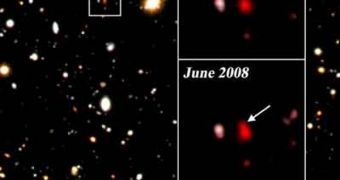For several years, astrophysicists have been saying that Type Ia supernova events are caused by white dwarf stars accreting mass until they exceed stability thresholds, which caused them to blow up. Now, a new investigation shows that the explosions are in fact produced by white dwarf mergers.
This class of cosmic objects is made up of the helium-burning remnants of Sun-sized stars. Once the precursor stars reach the end of their burning cycle, exhausting their hydrogen fuel supplies, they shed their outer atmosphere, and are left with a small, white core that burns helium.
Many white dwarfs can be found in binary systems, astronomers found out some time ago. Within these systems, one of the stars may be accreting mass from the other. Experts identified the source of Type Ia supernova events as lying within this process.
The thinking went that a star accreting mass beyond its stability limit would become unstable, and shed excess material in a thermonuclear explosion. These events are what we perceive as one of the two main types of supernova blasts, the theories said.
But an international team of researchers including American, Israeli and Japanese astronomers has now discovered that it's not excessive accretion that causes the explosions, but rather the mergers of white dwarfs in binary systems.
As this happens, a huge thermonuclear blast destroys both stars. “The nature of these events themselves is poorly understood, and there is a fierce debate about how these explosions ignite,” research scientist Dovi Poznanski explains.
The expert holds joint appointments as a postdoctoral fellow, at the US Department of Energy's (DOE) Lawrence Berkeley National Laboratory (Berkeley Lab) and the University of California in Berkeley (UCB). He is also one of the main authors of the new study.
“The main goal of this survey was to measure the statistics of a large population of supernovae at a very early time, to get a look at the possible star systems. Two white dwarfs merging can explain well what we are seeing,” he adds.
The data the team used in its investigations belong to the largest survey conducted to date on distant exploding stars. The work is published in the October issue of the journal Monthly Notices of the Royal Astronomical Society (MNRAS).

 14 DAY TRIAL //
14 DAY TRIAL //